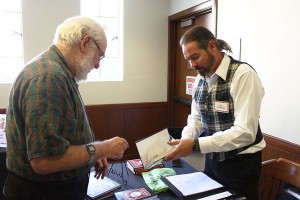Conference on Lewis Carroll attracts artists
Doheny Memorial Library hosted “Lewis Carroll Outsiders,” an annual conference on the lasting influence of Lewis Carroll, mathematician and writer of Alice’s Adventures in Wonderland, on Saturday.

Down the rabbit hole · Author Raul Contreras signs copies of his book, Alice’s Bloody Adventure in Wonderland at Doheny Memorial Library. – Jessica Zhou | Daily Trojan
Attendees of the event were greeted by a sculpture of distorted Alice in Wonderland characters when they entered the foyer of Doheny Library. Karen Mortillaro, sculptor and head of the Lewis Carroll Society of North America’s planning committee, created these sculptures for the event. The Lewis Carroll Society of North America puts on the daylong event.
“For my work, this is a wedding of word to imagery. Most of Lewis Carroll is flat book illustration,” Mortillaro said. “So being sculptural is taking it off the page and making it three-dimensional.”
The emphasis to bring something new to Alice was reiterated throughout the conference. Mortillaro said that the many different views of Carroll’s work was what made the author popular.
“If you look at the people in attendance here, they are an eclectic group,” Mortillaro said. “Some have a love of the books, some the illustrations. If you asked each one you’d get a different answer.”
The conference began with an “elevator pitch” session at 9:30 a.m., in which exhibitors of Alice merchandise pitched their Carrollian products, everything from animated Alice films to illustrations to biographies.
Attendees came from as far as Sweden and Lithuania to hear panelists who ranged from video game designer American McGee to USC recipients of the Wonderland Award, an arts and scholarship award for college students in California.
The first speaker of the day was Dan Bergevin, a publisher who created a collaborative illustrated version of Alice’s Adventures in Wonderland. He contacted artists through the portfolio website Behance and received 58 illustrations from 58 artists, only eight of which came from America. On a projector, he showed all the illustrations from the book. The styles ranged from gothic Alices to ’50s cartoon-style Alice characters.
“I don’t think I could have pulled it off without Tim Burton’s movie to pull it along,” Bergevin said of how the movie brought interest to the project. “I don’t think [some of the artists] realized that the book and the movie are different things.”
Bryan Talbot, writer and illustrator of the graphic novel Alice in Sunderland, joined the event via Skype from Sunderland, England. In a discussion moderated by USC professor Henry Jenkins, Talbot spoke of how John Tenniel’s classic illustrations of Carroll’s books influenced his work.
“I can’t remember a time when I didn’t know the Tenniel illustrations,” Talbot said.
Talbot’s book deals with the history of Sunderland, where Carroll wrote “The Jabberwocky” and its influence on the author. His knowledge of Sunderland and England was immense.
“[‘The Jabberwocky’] is very much based on northeastern legends,” Talbot said of the poem’s connection with Sunderland, which is located on the eastern coast of Britain.
Christopher Tyler, a neuroscientist and investigator of the historical context of Alice in Wonderland, spoke after Talbot. He presented his book Parallel Alices: Alice through the Looking-Glass of Eleanor of Aquitaine, which discusses historical influences on Alice, rather than focusing on the Alices Carroll knew.
“Lewis Carroll knew a lot of Alices,” Tyler said. “These are photographs of eight different Alices that he knew. This gives you a sampling of his own photographs and drawings.”
In the afternoon, USC students Lindsey Jones, a graduate student in liberal studies, and Andrew Woodham, a doctoral candidate in genetics, molecular and cellular biology, presented their winning projects. The two have each won the Wonderland Award twice. Because the two have won the award multiple times, they were introduced as the “King and Queen of Wonderland.”
Woodham’s inspiration for Queen Victoria of Hearts, a Queen of Hearts composed of morbid playing cards, came from the theory that the Queen of Hearts was a satire of Queen Victoria, who was the reigning monarch for most of Carroll’s life. Woodham said he was also inspired by Carroll’s book on mathematics, An Elementary Treatise on Determinants.
“The Wonderland Award lets us play around with things we wouldn’t in our ordinary endeavors,” Woodham said.
Jones presented a scrapbook and a chess set based on Alice Chess, a 1953 variation of chess played with a mirror.
McGee discussed his games American McGee’s Alice and its sequel Alice: Madness Returns.
“My background was with games like Doom and Quake, which tended to focus mainly on violence,” McGee said. “Coming out of that I saw a lot of opportunity for storytelling.”
Not everyone in the industry, however, saw game-making in the same light.
“There was a quote within the industry: ‘Story within games is as useful as story within pornography.’ The first thing I wanted to do was prove that wrong,” McGee said.
To prove the theory wrong, McGee honed in on Carroll.
“I began to brainstorm,” McGee said. “I was driving here in California and a song was playing, and the word ‘wonder’ was featured. And somehow when the word ‘wonder’ hit my brain, it felt like an epiphany that Alice could become a game.”
The event concluded with a tour of the Lewis Carroll Collection, a collection founded in 2000 with more than 3,000 rare documents relating to Carroll’s work.
Follow us on Twitter @dailytrojan

The visual arts may help to understand Carroll’s work better. Yet, most research on Carroll is textual. Thus, readers keep missin clues, as they for example are provided by Henry Holiday’s illustrations to Carroll’s “The Hunting of the Snark”.